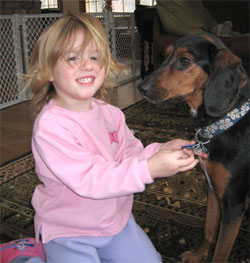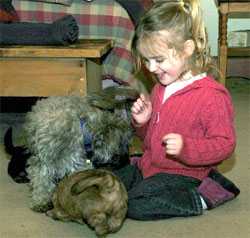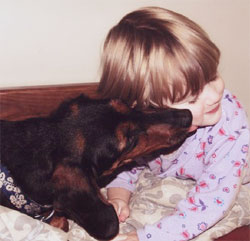Among the many presentations I’ve given are those to new parents regarding canine and feline behavioral-bond problems. And in spite of the fact that the best time to consider such issues is before the baby arrives, there are things that can be done after-the-fact to ensure both the animal’s and the baby’s well-being. Granted new parents often think that the new arrival leaves no time to worry about Spot or Kitty’s little quirks. However, unless something is done to address those behavioral issues, trust me, there’s a good chance they’re going to get worse. Because of this, this month we’re going to begin exploring a few topics relative to pets and kids, beginning with very young children and dogs.
 A common suggestion regarding introducing new babies to pets advises parents to make a big fuss over the dog so the pet won’t feel left out. The assumption is that this will prevent the dog from becoming jealous of the new baby and doing something nasty, like peeing on the nursery rug or growling at the child. However, such recommendations can backfire if the higher pitched baby-talk and overly solicitous tone new parents often use to communicate with the dog also communicates a lower rank. In that case, rather than reassuring Spot that his owners still love him, they could be telling him that he’s responsible for protecting them and this new addition. If Spot has the confidence to handle this added responsibility, no problems arise. However, if he doesn’t, then this well-intentioned, but misguided interaction can result in a variety of canine misbehaviors. Among these, we’re going to consider the two most common: marking and aggression.
A common suggestion regarding introducing new babies to pets advises parents to make a big fuss over the dog so the pet won’t feel left out. The assumption is that this will prevent the dog from becoming jealous of the new baby and doing something nasty, like peeing on the nursery rug or growling at the child. However, such recommendations can backfire if the higher pitched baby-talk and overly solicitous tone new parents often use to communicate with the dog also communicates a lower rank. In that case, rather than reassuring Spot that his owners still love him, they could be telling him that he’s responsible for protecting them and this new addition. If Spot has the confidence to handle this added responsibility, no problems arise. However, if he doesn’t, then this well-intentioned, but misguided interaction can result in a variety of canine misbehaviors. Among these, we’re going to consider the two most common: marking and aggression.
If Spot pees in, i.e. marks, the baby’s room, more likely than not he doesn’t do this in a fit of jealous rage or to punish his owners for bringing the new baby home. Quite the contrary. Babies enter our households, totally helpless and lying on their backs pooping and peeing. In other words, everything about them communicates submission and thus no threat to the average dog. However, if the owners have unwittingly communicated to Spot that he’s responsible for the baby via their relationship with the dog, then he may signal his willingness to protect her by marking her room with urine (most common) or stool (less common).
 “Why doesn’t he mark outside like a good dog?” you may very well ask. Well, because although Spot may not be particularly brave, he’s not stupid. Rather than signaling his willingness to fight to protect his owner’s yard, house, and everything and everyone inside by marking outside, he shrinks his territory and only marks that which he considers the most important or vulnerable, leaving the rest to fend for him-, her-, or itself. Once he does this, two responses further reinforce his behavior. The first is that none of those things he hoped to warn away with his mark—the Fed-X delivery person, the dog next door, the street sweeper—come into that nursery and harm the baby. The second is that his owners’ ranting and raging at him for doing this makes it clear that they lack the confidence to properly protect the baby themselves.
“Why doesn’t he mark outside like a good dog?” you may very well ask. Well, because although Spot may not be particularly brave, he’s not stupid. Rather than signaling his willingness to fight to protect his owner’s yard, house, and everything and everyone inside by marking outside, he shrinks his territory and only marks that which he considers the most important or vulnerable, leaving the rest to fend for him-, her-, or itself. Once he does this, two responses further reinforce his behavior. The first is that none of those things he hoped to warn away with his mark—the Fed-X delivery person, the dog next door, the street sweeper—come into that nursery and harm the baby. The second is that his owners’ ranting and raging at him for doing this makes it clear that they lack the confidence to properly protect the baby themselves.
Other dogs may become more aggressive following the baby’s arrival, and I can totally understand why some parents want to deny the negative potential of such displays by dismissing them as protective. However, if the dog is displaying aggression toward others—the delivery person, newspaper carrier, neighbors or dog next door—that the owners don’t consider threatening, then dismissing the canine behavior as protective is the same as admitting that they live in a dog-run household. It’s difficult enough for knowledgeable adults to predict how such dogs with their ultrasonic hearing, motion-sensitive vision, incredible sense of smell, and sometimes defensive response to pressure will react at any given moment. Predicting how these dogs will respond to an infant or toddler is even harder because even the youngest of kids have a way of doing unexpected things.
 Worse, dogs who target others in an attempt to protect members of what they consider their group (as opposed to viewing themselves as members of a human group) may not hesitate to target those family members who try to interfere with this process. Thus my files contain no shortage of cases in which a dog bit a child or parent when that person tried to stop the dog from menacing a visiting playmate.
Worse, dogs who target others in an attempt to protect members of what they consider their group (as opposed to viewing themselves as members of a human group) may not hesitate to target those family members who try to interfere with this process. Thus my files contain no shortage of cases in which a dog bit a child or parent when that person tried to stop the dog from menacing a visiting playmate.
Does all this mean that I think there’s no place for dogs in households with infants and toddlers? As these pictures of my granddaughter, Lauren, make clear, I don’t. However I do think that the stakes are way too high to a) say there’s no time to address the dog’s problems now, b) attach some emotion- rather than knowledge-based explanation to the display, c) deny the negative effects the stress underlying that negative behavior poses for the dog as well as others, or d) take a problem-oriented view to the dog’s behavior that ignores the underlying adult human-canine bond that’s fueling it.
Humans and dogs have co-evolved for thousands of years and a relationship with a dog that respects both canine and human needs adds a special dimension to the lives of humans of all ages. Consequently, it’s worth the time and effort it takes to do the job right. Besides, the same characteristics of quality human parenthood—consistency, patience, confidence, staying one step ahead rather than one behind—are the hallmarks of quality canine parenthood, too. So it’s not just a case of finding time in a busy schedule for working with the dog. It’s a matter of nailing down skills that will benefit your baby, too.
If you have any comments regarding subject matter, favorite links, or anything you’d like to see discussed on or added to this site, please let me know at mm@mmilani.com.
Among the many presentations I’ve given are those to new parents regarding canine and feline behavioral-bond problems. And in spite of the fact that the best time to consider such issues is before the baby arrives, there are things that can be done after-the-fact to ensure both the animal’s and the baby’s well-being. Granted new parents often think that the new arrival leaves no time to worry about Spot or Kitty’s little quirks. However, unless something is done to address those behavioral issues, trust me, there’s a good chance they’re going to get worse. Because of this, this month we’re going to begin exploring a few topics relative to pets and kids, beginning with very young children and dogs.
If Spot pees in, i.e. marks, the baby’s room, more likely than not he doesn’t do this in a fit of jealous rage or to punish his owners for bringing the new baby home. Quite the contrary. Babies enter our households, totally helpless and lying on their backs pooping and peeing. In other words, everything about them communicates submission and thus no threat to the average dog. However, if the owners have unwittingly communicated to Spot that he’s responsible for the baby via their relationship with the dog, then he may signal his willingness to protect her by marking her room with urine (most common) or stool (less common).
Other dogs may become more aggressive following the baby’s arrival, and I can totally understand why some parents want to deny the negative potential of such displays by dismissing them as protective. However, if the dog is displaying aggression toward others—the delivery person, newspaper carrier, neighbors or dog next door—that the owners don’t consider threatening, then dismissing the canine behavior as protective is the same as admitting that they live in a dog-run household. It’s difficult enough for knowledgeable adults to predict how such dogs with their ultrasonic hearing, motion-sensitive vision, incredible sense of smell, and sometimes defensive response to pressure will react at any given moment. Predicting how these dogs will respond to an infant or toddler is even harder because even the youngest of kids have a way of doing unexpected things.
Does all this mean that I think there’s no place for dogs in households with infants and toddlers? As these pictures of my granddaughter, Lauren, make clear, I don’t. However I do think that the stakes are way too high to a) say there’s no time to address the dog’s problems now, b) attach some emotion- rather than knowledge-based explanation to the display, c) deny the negative effects the stress underlying that negative behavior poses for the dog as well as others, or d) take a problem-oriented view to the dog’s behavior that ignores the underlying adult human-canine bond that’s fueling it.
Humans and dogs have co-evolved for thousands of years and a relationship with a dog that respects both canine and human needs adds a special dimension to the lives of humans of all ages. Consequently, it’s worth the time and effort it takes to do the job right. Besides, the same characteristics of quality human parenthood—consistency, patience, confidence, staying one step ahead rather than one behind—are the hallmarks of quality canine parenthood, too. So it’s not just a case of finding time in a busy schedule for working with the dog. It’s a matter of nailing down skills that will benefit your baby, too.
If you have any comments regarding subject matter, favorite links, or anything you’d like to see discussed on or added to this site, please let me know at mm@mmilani.com.